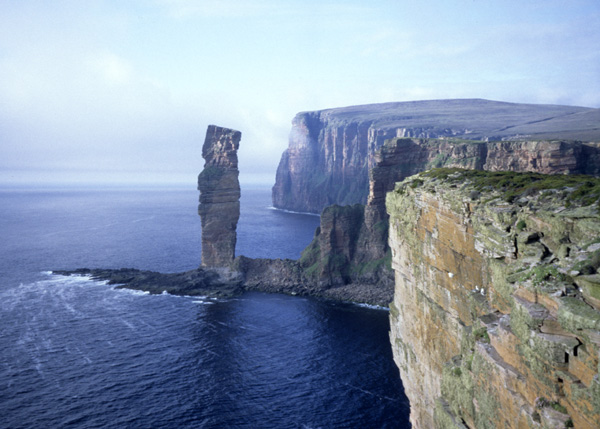
One of the highlights of the ferry crossing was when we passed near the Isle of Hoy and saw the massive stone column known as the “Old Man of Hoy”
Scapa
Flow Trip Report 2009
I was on the phone with Jerry at ISC and he asked me if I was interested in going to Scapa Flow Scotland with him and a few other meg instructors for some really cool wreck diving. “Of course” I said “when do we go?”. When Jerry told me we had to be on the boat the following Monday I was a quite dubious that I could get everything together on such short notice. First obstacle was my work boss. Despite making lots of gripes and groans he managed to juggle schedules and give me the nod. Next obstacle was the BIG boss. She begrudges me little but this was asking a lot of her since I know she really wants to go to Scotland too. It seems she was OK with it now flight bookings. When I plan a trip I usually go online well in advance and search out the bargains. I had no such luxury this time but decided if I could get a flight for under $2000 I would go. Well I found a flight in my price range but it was a 28hr milk run that would take me to Paris and Amsterdam before I reached my final flight destination of Humberside England. It turns out if you are going to have an eight-hour layover you could pick worse places than Amsterdam. The train to downtown is about 6euro and it leaves from the lower level of Schipol airport and takes you right downtown.
I arrived in Humberside, as tired as can be expected and was met by Jerry, who had arrived a day earlier and Dennis Vessey who was our host for this trip. I also met Oded Shaprut, a meg instructor from Eilat Israel. We of course had to stop by the pub on the way to Dennis’ where I was relieved to finally stretch my legs out and get refreshed. The next morning we awoke at 4am to commence the long drive to Scrabster Scotland to catch a ferry to the Orkney Islands. The long ten hour drive was actually quite enjoyable since Scotland is blessed with some breathtaking scenery and we even found a Castle to stop at for a quick tour and “birds of prey” show put on by the local falconer.
We finally arrived at the ferry dock and embarked on a two hour ferry ride. The MV Hamnavoe is about the size our own BC ferries but quite a bit more luxurious.

|
One of the highlights of the ferry crossing was when we passed near the Isle of Hoy and saw the massive stone column known as the “Old Man of Hoy”
|
| Shortly after passing Hoy we arrived in Stromness, which is a beautiful quaint Scottish town with a long and rich history. |  |
The Orkneys were probably first inhabited by humans during the last ice age who walked over on ice from Norway. The archaeological discoveries on these islands are amazing. We visited a Stonehenge like structure and a dig site that they believe will be the largest manmade building discovered from the Neolithic age.
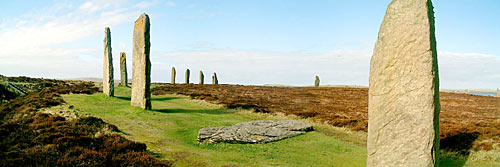
We also toured a museum and a distillery, which was interesting even if I’m not much of a scotch drinker the rolling fields of heather make for luxurious peat bogs that abound in the Orkneys and is a key ingredient for making Highland Park Whiskey.
The
diving:
OK
so enough of the other stuff now down to business. For those who don’t know
one of the more significant events that occurred in the Orkneys was the
scuttling of the German High Seas Fleet which was at anchor in Scapa Flow as
part of the disarmament treaty which was being hashed out in Versailles in 1919.
For several months 78 German ships await news of their fate when Rear-Admiral
Ludwig von Reuter gave the order for the German ships to scuttle their vessel
rather than have them fall into the control of the Royal Navy. Shortly after the
scuttling the Royal Navy salvage team began refloating and salvaging the shallow
water vessels but left those ships that were more than a few fathoms deep as
being too difficult to salvage. I was not until 1923 that the Scapa Flow Salvage
and Shipbreaking company purchased the rights to salvage the remaining vessels
that a massive operation that would last until 1939 resulted in the raising and
salvage of all but 7 of the German ships. The remaining ships were massive
battle ships and cruisers and proved to be too large and too deep to make
salvage feasible.
Many years later the advent of recreational scuba diving brought a whole new aspect to tourism at Scapa Flow. We arrived at the dock at Stromness and were greeted by Emily Turton, owner and skipper of the Radiant Queen This converted fishing trawler has been completely remodeled and equipped for scuba diving in the rugged conditions of the North Sea. The ladder is rigged mid-ships and is long enough and at just the right slant to allow a fully rigged diver to easily climb out in the liveliest of sea states. |
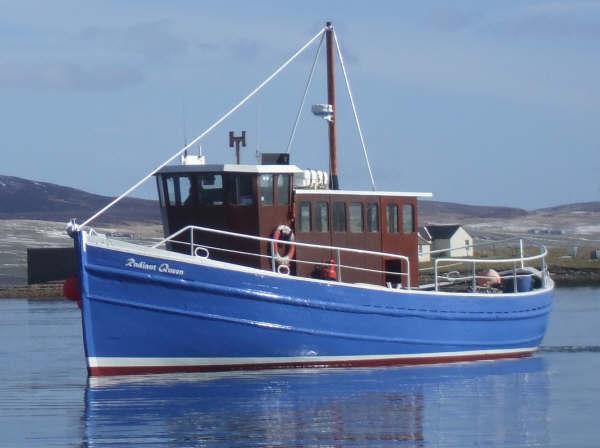
|
Emily managed the boat handling chores as well as any skipper I have ever seen and on top of that blends nitrox and fills cylinder, gives the most detailed and complete dive briefings I have ever had and to top it off cooks the meals which includes home baked deserts as well as yummy main courses. During the week one of the divers celebrated his 40th birthday and Emily ensured the event was commemorated with a delicious chocolate dipped strawberry cake

The week of diving commenced with a dive on the SMS Koln, a 491ft light cruiser
This was a perfect shakedown dive as the wreck lies in 100fsw and is fairly intact so we had an enjoyable 82 minute dive swimming around the outside of this massive wreck. I was impressed to see several of the 5.9inch guns sticking out from under the upsidedown hull. I was quite surprised at how warm the water was and even though the visability was not as clear as many tropical dives I had done was certainly better than expected for such a northerly destination
Our second dive of the day took us to the SMS Brummer
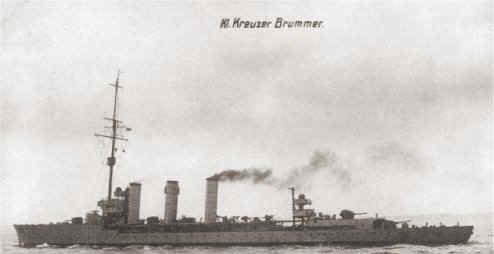
again although these 2 ships looked massive to me they were soon dwarfed by what was to follow. I did see my first conger eel peering out of the breech of a 5.9inch gun near the stern. This dive I logged a max depth of 115fsw and a total run time of 77 minutes
Day two of the trip began with a dive to the SMS Dresden, another light cruiser
This photo shows the white flag which was the signal used by Adm von Reuter to commence the scuttling of the High Seas Fleet.
This dive was to a max depth of 120fsw and lasted 81 minutes.
During the pre-dive briefing for the second dive of the day, SMS Kronprinz Wilhelm, Emily commented that we should pay particular attention to the stern of this ship. She pointed out it had the cutest little bum and if it could fart…. Well it’s hard to describe but she certainly painted a descriptive picture of a mighty German battleship with a tiny little bum that was every bit as cute as described. It should be noted that battle cruisers were designed to be maneuverable and to fight on the move while battle ships were designed to fight from a reasonably stationary position mostly used for shore bombardment from their massive 12inch guns

As a result the rudders on a cruiser are quite large in relation to those found on a battleship, which is quite a bit larger ship.
Our dive on the Kronprinz Wilhelm was to a max depth of 117fsw and lasted a whopping 96 minutes (not bad for these northern waters)
Day three took us to the deepest of the German Fleet wrecks, the Markgraf. This massive battleship has a length of 575ft and a beam of 96ft. The visibility on this dive was less than we had seen on previous dives and the enormous size of the wreck made it easy to get lost swimming over the huge expanses of twisted jagged steel. Most of these ships have had parts and material salvaged off of them mostly using explosives to access the interior of the wreck. On this ship an area of the ship known as the citadel which is an area found on many warships consisting of a protected inner core where the ship can continue to fight and operate in spite of exterior damage. We found an exposed area of the citadel on this wreck that showed the sheer mass of a 12inch thick interior bulkhead, which ran though a major portion of the ship. Another interesting feature of this wreck was the enormous steam turbine engines. We found one to be quite intact and I was able to swim inside the turbine, not the casing but inside the turbine rotor itself for a photo op.
Our dive was to a max depth of 132 fsw and lasted for a total of 54 minutes. Up until this point all of our dives were mandatory decompression dives with deco lasting anywhere from 10-30 minutes.
For our second dive this day we went to a WWII blockship called the Tabarka. Blockships were intentionally sunk to make it difficult for U-boats to enter Scapa Flow and launch attacks on Royal Navy ships operating out of the port. This area is on the outer portion of the Flow and is very tide dependant as the tides rip though there except for a brief period of a tide change. We sat geared up waiting patiently for the order from the bridge to “Go, Go. Go!”. Twelve divers hit the water at the right moment with instructions to swim directly down and let the current draw you to the wreck. If you miss the wreck you are to surface immediately and Emily would pick you up for a second chance of making the narrow tide window to dive this wreck. The Tabarka was a 2600-ton freighter. The water was gin clear and the wreck abounded with marine life. One of the more notable features of the wreck were the triple expansion steam engine and the three scotch marine boilers that had fallen away from their mounts in the now upside-down wreck. I did find a rather large Atlantic lobster on this wreck but he was too fast to be an honoured dinner guest. Shortly after entering the water for this dive I noticed a trickle of water entering my drysuit on my right upper thigh. This leak was quite annoying and soon was making me feel rather cold. After about 35minutes of this I had enough cold water in my suit that I decided I was done. I exited the wreck though a hole in the hull and inflated my smb for the short drift to the surface. A surface marker is essential on this dive especially when diving with a rebreather since I soon drifted quite a distance from the wreck the Radiant Queen looked rather small in the distance as Emily was helping other divers board her boat. She soon spotted our group and we gave her the agreed upon signal to identify us as her divers since there were two other boats making use of the slack tide to dive in the area.
Back on the boat I found my suit completely flooded and I was soaked from my chest to my toes. Luckily for me the operator of a shop called Scapa Scuba makes and repairs drysuits and offers quick turnaround drysuit repairs at a reasonable price. I was able to have my suit repaired and pressure tested and sitting on the boat the following morning. This is a very valuable service for such a remote location where diving is what it’s all about for many of us.
On day four we descended on the battleship SMS Konig which the first of the class of battleship of the same name and like the SMS Markgraf is an enormous structure. One of the notable features of this wreck is the ship is on its side and the weight of the superstructure has caused the forward end of the upper deck to fold over itself and the massive gun turrets and anchor capstans sit on top of each other . This dive was to a max depth of 118fsw and was 83minutes in duration.
The second dive of day four was the Karlsruhe which was the third large battleship of the group but as well as being the shallowest was also the most heavily damaged by salvage operations. This leaves the wreck quite open and we were able explore areas of the wreck which we were unable to see on other ships of its kind without extreme wreck penetration procedures.
This scanned image shows how open the hull of this upside-down wreck actually is.
[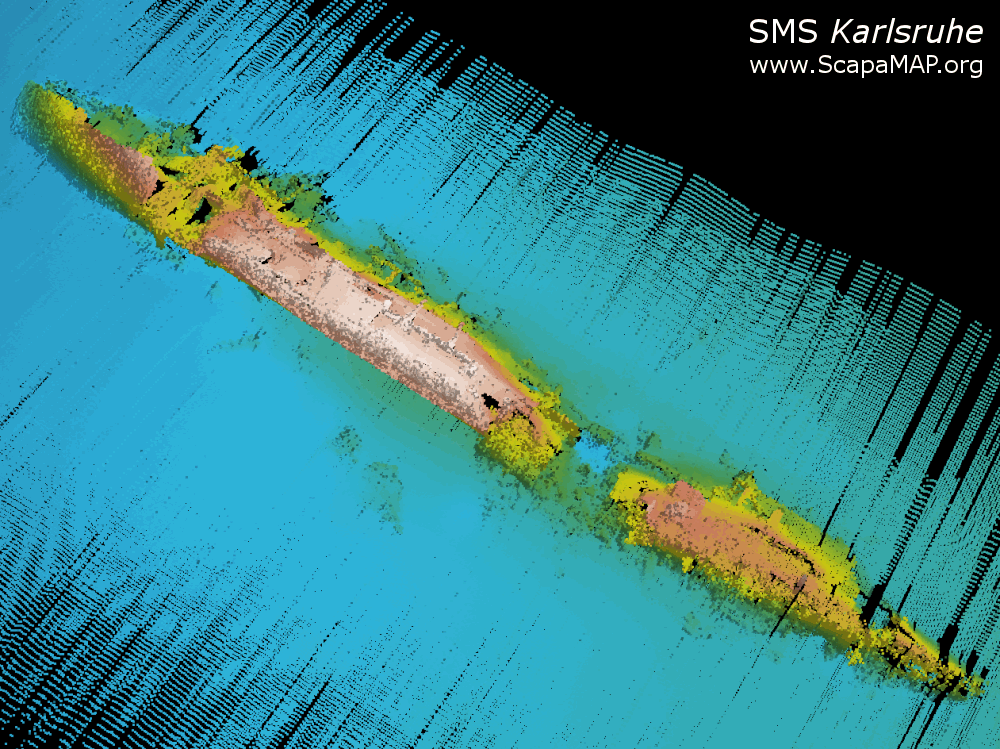
Our dive on this wreck was to 88fsw for 86 minutes. There was almost no decompression required due to the shallow depth so almost all the time was spent on the bottom.
During the fourth day Emily had looked at the weather forecast and decided the weather on Friday would not be very good and we could either do a third dive on Thursday or we could get an early start on Friday and get at least one good dive in before the high winds made diving impossible. We opted to board the boat at 7am and we headed out to the SMS Koln for a second dive. On our way out the gusting wind was whipping the tops off the whitecaps and it was obvious the seas were building rapidly. We made our way to the Koln but I was soon to discover my rebreather buddies were not going to be diving today. Luckily for me Chris, (the birthday boy) was in need of a buddy as his wife Ellie had stayed ashore today. Although Chris was diving open circuit he made a very well executed survey of the wreck. He led me to the stern where we penetrated the second deck and swam through to the centre of the ship where the hull was opened up. We then swam forward to the bow where we could see the full length of the bow lying on its side. Chris then slipped though a hull plate that was peeled back slightly and we were soon inside the second deck which ran the full length of the forward end where we emerged at the opened mid-section and made our ascent. Even though I had been on this wreck once before Chris showed me a whole different perspective of this ship and it became clear to me I will have to do many more dives on these wrecks before I will even start to understand the structure and construction of these relics of history
When we emerged from our last dive it was obvious the weather was deteriorating rapidly. The wave height was a good 3-4ft and the wind was whipping them into a white foamy sea. Emily spotted our bright orange SMB and soon placed the boat upwind of us for us to board in the in the relative calm of the boat’s lee. I can`t say enough about how impressed I was with the professionalism displayed by Emily and her charter operation. As a professional mariner myself I have rarely seen such precise boat handling especially an old single screw former trawler such as the Radiant Queen. You can be sure I will be returning to Scapa Flow for some more diving and I will certainly engage the services of the Radiant Queen for my next trip.